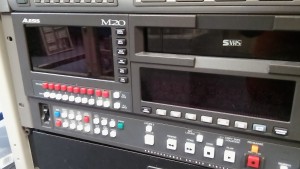The Alesis ADAT digital multi-track tape recorder is an iconic piece of early 1990s audio recording equipment.
ADATs used consumer S-VHS video tape to record up to 8 tracks of digital audio.
They were modular, meaning that each machine could be synched with up to 15 other ADA
Similar to other early digital audio technology such as PCM 7030 and DAT, ADAT utilised recording methods originally developed for analogue video tape.
In analogue video the use of helical scanning and rotating recording/ playback heads was the means to produce the larger bandwidth necessary to capture the analogue video signal.
Helical scanning was logically re-purposed for recording digital audio because it similarly requires substantial bandwidth (the original ADAT recorded at a sampling rate of 48 kHz/ 16 bits).
Recording revolution
According to George Petersen ‘the Alesis ADAT changed the entire recording industry, beginning a revolution of affordable recording tools. Overnight, the cost of digital studio recording plummeted from a sizeable $150,000 for the Sony PCM-3324 24-track to a relatively modest $12,000 for three ADATs at their original $3,995.’
Figures from the Audio Engineering Society suggest that ‘20,000 were sold in its first year from October 1992 to November 1993 and 80,000 sold by 1998.’
Sound studies scholar Jonathan Sterne argues that ‘ADATs were symbolic of the democratization of audio recordings and changes in the audio industry,’ facilitating ‘the rise of amateur recording and a whole “semi-professional” realm of small studios, often located in homes or other less-than-optimal acoustic spaces.’
ADAT at Greatbear
At Greatbear we receive relatively few ADAT recordings in comparison with analogue multi-track formats.
This may be because ADAT is ‘recently obsolescent,’ and for everyday reasons users of this technology have not got around to migrating their archive to digital files.
Like all early digital audio formats recorded on tape, however, ADAT raise specific preservation concerns.
As we have stressed before, tape-based digital recordings do not degrade gracefully. They are subject to catastrophic rather than moderate signal loss. If the original recording has errors that prevent the ‘smooth’ playback of the tape (e.g., from clogged heads or the presence of dust), or there is any kind of damage to the tape surface (scratches or mould), this will create irreversible drop outs within the preservation copy.
As an emergent format used by people with a range of technical expertise, it seems reasonable to expect ADAT recording practices to be a little unsettled and experimental. The physical strain on both tape and transport in a heavy production environment must also be considered (the shuttling back and forth of the tape mechanism), as this would have shaped the quality of the original recording.
In the Greatbear studio we have several ADAT machines (the Alesis M20, ADAT XT and ADAT LX20) ready to transfer your tapes.
We deliver transferred files as individual, synchronised track ‘stems’ and use ADAT ‘sync’ and optical cables to ensure an authentic born digital workflow.
Perhaps now is the time to remix that early digital multi-track masterpiece…

